List of armouries in Canada
A number of armouries and drill halls exist in communities across Canada. Of these, the majority were built in Ontario.
Architecture
Chief Dominion Architects
The Chief Dominion Architect(s) designed a number of prominent public buildings in Canada including armouries, drill halls, post offices, and Dominion Public Buildings : Thomas Seaton Scott (1871–1881); Thomas Fuller (1881–1897); David Ewart (1897–1914); Edgar Lewis Horwood (1914–1918); Richard Cotsman Wright (1918–1927); Thomas W. Fuller (1927–1936), Charles D. Sutherland (1936–1947); Joseph Charles Gustave Brault (1947–1952)[1]
Thomas Seaton Scott, Thomas Fuller and Thomas W. Fuller adopted the Dominion Style Neo-Gothic style. David Ewart embraced the Baronial style. The armouries may display Gothic Revival (1740s+), Tudorbethan (1835–1885+), Romanesque Revival (1840–1930); Colonial Revival (1890s+); Châteauesque (1887–1930) or Edwardian Baroque 1901-1922 style.
Drawings for virtually all armoury and drill hall buildings designed by The Chief Dominion Architect and his staff during his tenure as Chief Architect of the Department of Public Works are now held at the National Archives of Canada, Ottawa, Ontario.[2]
In some cases, architects obtained the commission to design these buildings in collaboration with the staff architects in the federal Department of the Militia in Ottawa.
Staff architects in the Federal Department of the Militia
Militia and defense buildings in Canada which were not designed by the Dept. of Public Works were the responsibility of staff architects in the Federal Department of the Militia. Staff architects inspected and oversaw the design, construction and maintenance of Militia buildings, and designed the Munitions Stores buildings which were often erected adjacent to Drill Hall buildings to storage weapons, uniforms, and ammunition. From 1886-1893, Henry James served as Chief Architect for the federal Militia Department. Lieutenant Frederick W. White succeeded as Chief Architect for the federal Militia Department 1893-1897.[3] Lieutenant Paul Weatherbe succeeded as Chief Architect and Engineer from 1897-1905.[4]
History
During the 1860s, the American Civil War and the Fenian Raids raised fears for the defence of British North America. In response, the Canadian militia was strengthened, and many rural communities erected a drill hall to train their volunteers.
During the early stages of construction, in the 1870s to 1890s, rural militia units, rather than the Department of Defence, were responsible for their construction. Armouries are centrally and prominently located in the historic city or town centers, and are well-known community landmarks.
Eleven drill halls were built in Ontario between 1876 and 1918 to improve the Canadian military as part of a campaign to reform and expand the Active Volunteer Militia. This period of reform turned the Canadian militia from a poorly equipped citizens' militia into an organized, competent fighting unit that was well prepared for the First World War. Designed with classical inspiration, the brick buildings are box-like with a flat roof, stonework on the base, crenellation, and Parapet walls.
From 1896 to 1918 over 100 drill halls and armouries were erected across Canada.
The armouries functioned as training and recruitment centres during First World War, and later for the Second World War and the Korean War. The space generally doubles as an assembly / Lecture hall. Traditionally, armouries serve as the permanent regimental headquarters of the local militia and as a drill hall for Militia practice and training.
The standard North American armoury model incorporates medieval military features such as jutting towers, buttresses, dentilated stringcourses, corbelling, crenellations, battlements and a large troop door reminiscent of a fortified gate. The distinguishing characteristics include functional design, good quality materials, excellent craftsmanship and unobstructed volume of floor space in the drill hall enabled by a gable roof. The foundation is frequently stone with a concrete floor supporting a steel frame. The exterior walls are frequently constructed with red brick and quarry-faced stone generally limestone or sandstone with a course of arched wood sash windows and doors. An armoury generally enclose a large drill hall, messes, classrooms and storage facilities.
A number of ‘Standard Drill Hall Class E’ armouries were built in a straightforward utilitarian design with modest architectural embellishment in an Edwardian Baroque 1901-1922 style. The design incorporates a large, unobstructed drill hall with exposed steel trusses, its gallery and supporting arcades. The decorative Flemish style parapets, towers, crenellated turrets and a low wide arched entrance, reminiscent of a fortified gate show very good craftsmanship. Edwardian Baroque 1901-1922 armouries incorporate distinguishing features such as red brick with a stone foundation, stone sills, window surrounds and decorative shields which contribute to a powerful image of stability and stateliness. To evoke the impression of a medieval castle, the walls incorporate buttresses, parapets, crenellated moulding, corbelled stonework and crenellated towers flanking its troop door. The distinguishing characteristics include double or triple Tudor gothic arches and projecting surround at the front entrance, defence towers, and wall treatments which step out at the corners. To convey an image of solidity and impregnability, the building have small narrow windows, Bartizans, and small Turrets complete with firing slits.
Armouries constructed in 1920s and 1930s reflect the popularity of Colonial Revival (1890s+) styles derived from simplified French colonial architecture of the Baroque era.
During the 1930s, a number of inter-war armouries were built employing modern structural design with concrete floors supporting a steel frame gable roofed drill hall, the Hipped roof, prominent chimneys and exposed Warren trusses for its large, unobstructed space. The details of its entrance and exhibits the stylized and simplified Châteauesque (1887–1930) style details, which reflect contemporary interests in smooth surfaces and geometric volumes. The distinguishing characteristics include red brick and white limestone round towers, elaborate arched entrances, wood panelled entrance doors, heavy iron hardware and multi-paned glazing which reflect the revivalist design. The decorative elements including Stringcourses, Copings, window trims, concentric Tudor entrance arches, and carved plaques.
The armouries may be National Historic Sites of Canada, and/or classified or recognized as Federal Heritage Buildings because of their historical associations, architectural and environmental values.
During the 1950s, the Department of National Defence used a standard plan for a drill hall on several military bases, designed by the architect firm of Gordon S. Adamson & Associates featuring a simple and unadorned composition, and a standard layout.
Alphabetical listing (by community)
| Site | Date(s) & Architect | Designated | Location | Description | Image | |
|---|---|---|---|---|---|---|
| Colonel James Layton Ralston Armoury Acadia Street & Agnew Street |
1914-1915 David Ewart | Canada's Register of Historic Places; Recognized - 1990 Register of the Government of Canada Heritage Buildings | Amherst, Nova Scotia |
Housing The Nova Scotia Highlanders, this large, centrally-located stone and brick Baronial style building features two sturdy towers, a triple arched entrance way and a large drill hall. |
||
| Aurora Armoury 89 Mosley Street at Larmont Street |
1874 Thomas Seaton Scott | 1991 Recognized - Register of the Government of Canada Heritage Buildings | Aurora, Ontario |
"Built in 1874 as a Dominion style Neo-Gothic style drill shed for the 12th Battalion of Infantry or York Rangers, the Aurora Armoury was part of a network of defence training facilities for citizen soldiers. It evokes the larger stories and traditions of the province's militia regiments, recruited regionally, and possessing close affiliations with their communities of origin. The armoury was also the site of Edward Blake's famous "Aurora speech" of 1874, in which the prominent politician and former Ontario premier called upon the federal government of Liberal Prime Minister Alexander Mackenzie to implement nationalistic and electoral reforms. The speech exemplifies how drill halls and armouries fulfil civic roles in the lives of their communities. The oldest purpose-built armoury still used by the military in Ontario, the Aurora drill shed is home to elements of The Queen's York Rangers (1st American Regiment) (RCAC)". Ontario Heritage Trust |
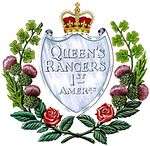 | |
| Baddeck Armoury | 1901 David Ewart | Baddeck, Nova Scotia |
Centrally-located Baronial style building with a hipped-roof. |
|||
| Barrie Armoury 37 Parkside Dr at High Street |
1913-14 David Ewart | 1997 Recognized - Register of the Government of Canada Heritage Buildings | Barrie, Ontario |
Housing The Grey and Simcoe Foresters, this large, mansard roofed Baronial style structure with sturdy projecting towers and a three-arched entrance is in a residential area near the centre of the city. |
 | |
| Mulcaster Street Armoury 36 Mulcaster Street |
19th century | Canada's Register of Historic Places | Barrie, Ontario |
Small scale, brick armoury features a centre assembly hall with right and left wings, under 3 roofs. |
||
| Col CC Gammon Armoury 1820 King Avenue |
Bathurst, New Brunswick |
Housing the North Shore Regiment, this centrally located drill hall projects a solid, fortified appearance. |
||||
| Shenley Armoury 551 Route Kennedy |
Beauceville, Quebec | |||||
| Beauport Armoury or Building 1 Du Manège Street |
1913-4 David Ewart | Canada's Register of Historic Places; Recognized - 1991 Register of the Government of Canada Heritage Buildings; | Beauport, Quebec |
Centrally located two-storey, red brick Baronial style drill hall with a low-pitched, gable-roof. |
 | |
| Belleville Armoury 187 Pinnacle Road at Bridge Street East |
1907-8 David Ewart | Canada's Register of Historic Places;1992 Recognized - Register of the Government of Canada Heritage Buildings | Belleville, Ontario |
Housing The Hastings and Prince Edward Regiment, this centrally located, low-pitched gambrel-roofed, stone and brick Baronial style building features a pair of tall towers. |
||
| Brampton Armoury 2 Chapel Street |
1914-15 David Ewart | 1991 Recognized - Register of the Government of Canada Heritage Buildings | Brampton, Ontario |
Housing "B" Company of the Lorne Scots, this centrally located, mid-size, rectangular Baronial style building has a low-pitched gable roof. The Lorne Scots Regimental Museum is located behind the Brampton Armoury. |
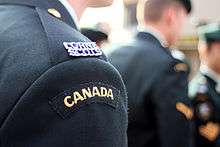 | |
| Brandon Armoury 1116 Victoria Avenue |
1907-8 David Ewart | Canada's Register of Historic Places; Recognized - 1994 Register of the Government of Canada Heritage Buildings | Brandon, Manitoba |
A solid looking Baronial style structure constructed of brick and stone featuring a three-storey midsection located in a mixed commercial and residential area. |
||
| Brantford Armoury 18 Brant Avenue |
1893 Henry James[6] David Ewart | 1992 Recognized - Register of the Government of Canada Heritage Buildings | Brantford, Ontario | Housing 56th Field Artillery Regiment, RCA, centrally located near the War Memorial; the Baronial style drill hall with a low-pitched gable roof is fronted by a monumental, fortress-like façade of brick and stone. |  | |
| Brockville Armoury 1-9 East Avenue facing 144 King St E |
1900-1 David Ewart | 1990 Recognized - Register of the Government of Canada Heritage Buildings | Brockville, Ontario | Housing The Brockville Rifles, this centrally located, large, low-massed, stone structure in the Baronial style features a low-pitched gable roof. |  | |
| Burford Armoury King Street |
1905 David Ewart | Burford, Ontario |
This centrally located, large, low-massed, structure in the Baronial style features a low-pitched gable roof. |
|||
| Mewata Drill Hall / Calgary Drill Hall 801 11th St. SW,[7][8] |
1916-17 (completed) Edgar Lewis Horwood | 1989 National Historic Sites of Canada; Recognized - 1984 Register of the Government of Canada Heritage Buildings; | Calgary 51°02′45″N 114°05′20″W / 51.04583°N 114.08889°W |
Housing The Calgary Highlanders, this centrally located large-scale, low-massed drill hall in the Tudorbethan style, whose scale and prominent location of which exemplifies the national pride that greeted Canada's strong performance in the South African War and the First World War. |
 | |
| Cambridge Armoury Ainslie Street South |
1914-5 David Ewart | 1987 Recognized - Register of the Government of Canada Heritage Buildings | Cambridge, Ontario |
Housing The Royal Highland Fusiliers of Canada, this centrally located, brick and stone Baronial style structure features a façade, flanking towers and a low-pitched gable roof; it projects a solid, fortified appearance. |
||
| Water Street Armoury 169 to 171 Water Street |
Campbellton, New Brunswick | |||||
| Cape Breton Armoury | Cape Breton, Nova Scotia | drill hall with a low-pitched gable roof | ||||
| Queen Charlotte Armoury 3 Haviland Street |
Charlottetown, Prince Edward Island | |||||
| Chatham Armoury Colborne Street |
1905 David Ewart | Chatham, Ontario |
Housing The Essex and Kent Scottish, this two-storey, red brick Baronial style structure with a low-pitched gable roof. |
|||
| Galipoli Armoury O'Connell Drive |
Corner Brook, Newfoundland | Large centrally located building with a low-pitched gable roof. | ||||
| Cornwall Armoury 505 4th Street East at Marlborough Street |
1938-9 Charles D. Sutherland | 1996 Recognized - Register of the Government of Canada Heritage Buildings | Cornwall, Ontario |
Housing The Stormont, Dundas and Glengarry Highlanders, and Stormont, Dundas and Glengarry Highlanders Regimental Museum[9] this centrally located Tudorbethan building with a low-pitched gable roof was constructed of buff-coloured brick with stone trim. |
 | |
| Coaticook Armoury | 1914 David Ewart | Coaticook, Quebec |
This Baronial style building has a low-pitched gable roof. |
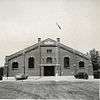 | ||
| Cobourg Armoury King Street |
1904 David Ewart | Cobourg, Ontario |
Housing The Hastings and Prince Edward Regiment, this Baronial style building has a low-pitched gable roof. |
|||
| Arm Lads Brigade Armoury PO Box 83 17 Museum Rd.[10] |
1910 David Ewart | Durrell, Newfoundland and Labrador | One-story red brick structure housing Durrell Museum[11] | |||
| St. Lambert Armoury | 1928 Simeon Brais | St. Lambert, Quebec | structure housing the Chateauguay Regiment | |||
| St-Louis Street Armoury 250 St-Louis Street |
Drummondville, Quebec | |||||
| Dundas Armoury King Street at Market Street |
1900 David Ewart | Dundas, Ontario |
Large centrally located Baronial style building with a low-pitched gable roof. |
|||
| Durham Armoury Garafraxa Street |
1908 David Ewart | Durham, Ontario |
Large centrally located Romanesque Revival building with a low-pitched gable roof. |
|||
| Connaught Armoury 85th Avenue |
1911 David Ewart | Canada's Register of Historic Places | Edmonton, Alberta |
The oldest armoury in Alberta, this two-storey, rectangular brick Baronial style building with a low-pitched gable roof, was built in the historic district to house 19th Alberta Dragoons. |
 | |
| Prince of Wales Armouries Heritage Centre 10440 - 108 Avenue |
1913-5 Donald Norman MacVicar | Canada's Register of Historic Places | Edmonton, Alberta |
Two-storey, rectangular brick and sandstone Tudorbethan building with distinctive corner towers evocative of medieval castle design on 0.96 hectares just north of the commercial centre houses The Loyal Edmonton Regiment Military Museum,[12] City of Edmonton Archives[13] and Telephone Historical Centre[14] |
 | |
| Hudson's Bay Company Stables Ortona Armoury 9722 - 102 Street |
1914 David Ewart | Canada's Register of Historic Places | Edmonton, Alberta | Alberta |
Restored two-storey, U-shaped Baronial style building with load bearing brick walls and stone detailing. |
|
| Land Titles Building – Victoria Armoury 10523 - 100 Avenue |
1893 Thomas Fuller (architect) | Canada's Register of Historic Places | Edmonton, Alberta |
One and one-half storey Neo-Gothic style building of brick covered in stucco. |
||
| Former Elora Drill Shed[15] 40 High Street, Centre Wellington |
1865 (completed) | 1989 National Historic Sites of Canada | Elora, Ontario 43°40′48.2″N 80°25′44.01″W / 43.680056°N 80.4288917°W |
"This handsome Tudorbethan stone structure, built in 1865, is a rare surviving example of early drill hall architecture in Canada. During the 1860s, the American Civil War and the Fenian Raids raised fears for the defence of British North America. In response, the Canadian militia was strengthened, and many rural communities erected drill halls to train their volunteers. Notable for its classical proportions, its semicircular fanlight over the door and oculus in the gable, this is an unusually well-constructed building of its type." Historic Sites and Monuments Board of Canada plaque |
 | |
| Enderby Drill Hall George Street |
1914 David Ewart | Enderby, British Columbia |
Built for $15,000 of Enderby bricks on donated land, the 42' x 92' Baronial style building, which housed C. Squadron B.C. Horse and the 172nd Battalion Rocky Mountain Rangers, has a birch floor and a single front door.[16] |
|||
| Carlton Street Armoury Campbell Street and Carleton Street |
Fredericton, New Brunswick |
Housing 1st Battalion, The Royal New Brunswick Regiment (Carlton and York), this centrally located, drill hall projects a solid, fortified appearance. |
||||
| Fraserville Armoury | 1910 David Ewart | Fraserville, Quebec |
Designed in a Baronial style, this centrally located massive, fortress-like building is centrally located. |
|||
| Gagetown Drill Hall | 1954 Gordon S. Adamson & Associates | D5 Recognized - 2004; H12 Recognized - 2004 on the Register of the Government of Canada Heritage Buildings | Gagetown, New Brunswick |
Large centrally located building with a low-pitched gable roof. |
H12 | |
| Galt Armoury Mill Street |
1914 David Ewart | Galt, Ontario |
Large centrally located Baronial style building with a low-pitched gable roof. |
 | ||
| Salaberry Armoury 188 Alexandre Taché Blvd & and boul St-Joseph |
1938 (completed) Lucien Sarra-Bournet | Canada's Register of Historic Places; Recognized - 1993 Register of the Government of Canada Heritage Buildings | Gatineau, Quebec |
Centrally located Romanesque Revival building with a steeply pitched gable roof houses Régiment de Hull. |
||
| Col J.R. Barber Armoury 91 Todd Road |
Canada's Register of Historic Places | Georgetown, Ontario |
Centrally located structure with a low-pitched gable roof houses C Company, Halton Company, The Lorne Scots, 32 Canadian Brigade Group |
 | ||
| Memorial Avenue Armoury 1A Memorial Avenue |
Grand Falls-Windsor, Newfoundland | |||||
| Guelph Armoury Farquahar Street at Wyndham Street |
1906-7 David Ewart | 1991 Recognized on the Register of the Government of Canada Heritage Buildings; Canada's Register of Historic Places | Guelph, Ontario |
Housing 11th Field Artillery Regiment, RCA, designed in a late Baronial style, this centrally located massive, fortress-like brick building is heavily ornamented and centrally located on a sloped site. |
 | |
| Halifax Armoury 2667 North Park Street at Cunard Street |
1895-99 (completed) Thomas Fuller (architect) | National Historic Sites of Canada; Classified - 1991 Register of the Government of Canada Heritage Buildings | Halifax, Nova Scotia |
Housing 1st (Halifax-Dartmouth) Field Artillery Regiment, and The Princess Louise Fusiliers this large, urban, Neo-Gothic style drill hall, was built for the active militia, of red rough faced brick. |
||
| John Weir Foote Armoury 200 James Street North |
1887 Henry James[17] 1888-1908 Thomas Fuller (architect)/ David Ewart | 1989 National Historic Sites of Canada;1991 Classified on the Register of the Government of Canada Heritage Buildings | Hamilton 43°15′42.76″N 79°51′58.42″W / 43.2618778°N 79.8662278°W |
Named after John Weir Foote, one large Neo-Gothic style Dominion style complex is composed of two armouries. The north section of the building is representative of the second evolutionary stage in drill hall construction in Canada (in the 1870s to 1890s). Houses Argyll and Sutherland Highlanders of Canada (Princess Louise's); The Royal Hamilton Light Infantry (Wentworth Regiment); 2nd Field Artillery Regiment, RCA. |
| |
| Indian Head Armoury 708 Otterloo Street |
1914 Engineer Service Branch, Dep't of Militia and Defence | Standard Armoury Plan Type A | Indian Head, Saskatchewan | Baronial style. Originally housed C Squadron of the 16th Light Horse Regiment. Formally opened 18 February 1914 by Colonel Sam Steele then commander of Military Division 10, Winnipeg. |  | |
| Joliette Armoury Park Street |
1909 David Ewart | Joliette, Quebec |
This Baronial style structure is centrally located. |
|||
| JR Vicars Armoury 1221 Mcgill Rd |
1902 David Ewart | Kamloops, British Columbia | Housing The Rocky Mountain Rangers, this Baronial style structure is centrally located. | |||
| Brigadier Angle Armoury 720 Lawrence Avenue |
1904 David Ewart | Canada's Register of Historic Places; Recognized - 1997 Register of the Government of Canada Heritage Buildings | Kelowna, British Columbia | One-storey, T-shaped Baronial style structure with a hipped-roof, clad in aluminum siding. | ||
| Kingston Drill Hall 100 Montreal Street |
1899-1899 David Ewart | 1989 Classified on the Register of the Government of Canada Heritage Buildings | Kingston, Ontario |
Housing The Princess of Wales' Own Regiment and Princess of Wales' Own Regiment Military Museum [18] this two-storey, heavy stone Baronial style structure is located in a residential and commercial district in the former Royal Artillery Park. |
||
| Kitchener Armoury 350 East Avenue |
Kitchener, Ontario |
Housing Waterloo Region Corp 1596 (Royal Canadian Army Cadets) & KW Spitfire Squadron (Royal Canadian Air Cadets) World War II Canadian Women’s Army Corps monument (2000) 6’4” high bronze by André Gauthier (sculptor) |
||||
| Lévis Armoury 10 de l'Arsenal Street; St. David Street at St. Antoine Street |
1911-4 David Ewart | Canada's Register of Historic Places; Recognized - 1991 Register of the Government of Canada Heritage Buildings; | Lévis, Quebec |
Housing Le Régiment de la Chaudière, this centrally located two-storey Baronial style stone structure has a copper hipped roof. |
 | |
| London Armoury Dundas, Richmond, Wellington and King Street |
1902-3 David Ewart | Canada's Register of Historic Places; | London, Ontario |
Housing 4th Battalion The Royal Canadian Regiment, this large centrally located Baronial style building has a low-pitched gable roof. |
 | |
| Matane Armoury 374 St. Jerome Street |
1913 David Ewart | Canada's Register of Historic Places; Recognized - 1991 Register of the Government of Canada Heritage Buildings | Matane, Quebec |
Centrally located two-storey, red brick Baronial style building with a green-painted, metal clad hipped roof. |
 | |
| St Jerôme Street Armoury 374-376 St Jerôme Street |
Matane, Quebec | |||||
| Middleton Armoury 150 Commercial Street |
1902 David Ewart | Canada's Register of Historic Places; Recognized - 1993 Register of the Government of Canada Heritage Buildings | Middleton, Nova Scotia |
Centrally located, Baronial style building with wooden construction and classical detailing. |
||
| George Street Armoury George Street |
Miramichi, New Brunswick | |||||
| Canadian Grenadier Guards’ Armoury 4171 Esplanade Avenue |
1913-14 Donald Norman MacVicar | Canada's Register of Historic Places; Recognized - 1994 Register of the Government of Canada Heritage Buildings | Montreal | Large, two-storey, brick Baronial style drill hall with a low-pitched gable roof is on a residential streetscape in Montreal. |  | |
| Black Watch Armoury 2067 Bleury Street |
1905-06 (completed) Samuel Arnold Finley and David Jerome Spence[19] | 2008 National Historic Sites of Canada;Recognized - 1994 Register of the Government of Canada Heritage Buildings | Montreal 45°30′28.37″N 73°34′11.38″W / 45.5078806°N 73.5698278°W |
The centrally located two-storey, brick Baronial style drill hall with a stone-clad façade is home to The Black Watch (Royal Highland Regiment) of Canada and regimental museum, one of Canada's oldest regiments and its oldest surviving Highland Regiment; a testament to the important roles played by armouries in Canada's military history. |
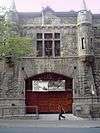 | |
| Côte des Neiges Armoury 4185 Chemin de la Côte des Neiges |
1934-35 Thomas W. Fuller | Canada's Register of Historic Places; Recognized - 1991 Register of the Government of Canada Heritage Buildings | Montreal, Quebec |
On a treed site on the southwest perimeter of Mount Royal Park, this Châteauesque structure houses The Royal Canadian Hussars (Montreal); 2nd Field Regiment, Royal Canadian Artillery. |
||
| Victoria Rifles Armoury 691 Cathcart Street |
1933 Thomas W. Fuller | Canada's Register of Historic Places; Recognized - 1984 Register of the Government of Canada Heritage Buildings | Montreal, Quebec |
Housing Le Régiment de Maisonneuve, this Gothic Revival armoury`s two-dimensional façade with a low-pitched gable roof is pressed up against its urban streetscape. |
 | |
| Westmount Armoury 4625 Ste-Catherine Street West |
1925 Richard Cotsman Wright | Canada's Register of Historic Places | Westmount, Quebec |
Housing The Royal Montreal Regiment, and regimental museum, this two-storey, red brick Châteauesque building in a residential neighbourhood is set in landscaped grounds planted with mature trees. |
 | |
| St-Joseph Boulevard E Armoury 160 St-Joseph Boulevard E |
Montreal, Quebec | |||||
| Manège Henri-Julien 3721 Henri Julien Street |
1911 Raoul Adolphe Brassard | Canada's Register of Historic Places; Recognized - 1992 Register of the Government of Canada Heritage Buildings | Montreal, Quebec |
Housing Les Fusiliers Mont-Royal, this centrally located Baronial style armoury, which includes a regimental museum, is on a corner site, in a densely packed, mixed neighbourhood. |
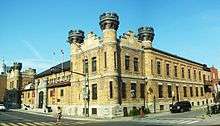 | |
| Montmagny Armoury Depot Street |
1915 Edgar L. Horwood | Canada's Register of Historic Places; Recognized - 1991 Register of the Government of Canada Heritage Buildings | Montmagny, Quebec |
Centrally located, mid-size, rectangular Romanesque Revival building with a low-pitched gable roof. |
||
| Colonel D. V. Currie VC Armoury 1215 Main Street North |
1913-14 David Ewart | 1998 Register of the Government of Canada Heritage Buildings | Moose Jaw, Saskatchewan |
Large, low-massed Baronial style brick structure is located in a mixed commercial, recreational and residential neighbourhood. Currently the home of the Saskatchewan Dragoons; it has housed 95th Saskatchewan Rifles, the 60th Rifles, the King’s Own Rifles of Canada, the 77th Battery, Royal Canadian Artillery, the 19th Medical Company, Royal Canadian Army Medical Corps, and the 142nd Transport Company, Royal Canadian Army Service Corps. |
||
| Naden Armoury CFB Esquimalt |
1935-6 Karl Branwhite Spurgin[20] | Recognized - 1991 Register of the Government of Canada Heritage Buildings | Naden, British Columbia |
Large centrally located Royal Canadian Navy Drill Hall & Administration Building with a low-pitched gable roof (33-33A-33B). |
||
| Napanee Armoury Centre Street |
1914 David Ewart | Napanee, Ontario |
Large centrally located Baronial style building with a low-pitched gable roof. |
|||
| New Glasgow Armoury Skinner Street at Kemp Street |
New Glasgow, Nova Scotia |
Housing The Nova Scotia Highlanders, this centrally located building has a flat roof. |
||||
| The Armouries 530 Queen's Ave at 6th Street |
1895 Thomas Fuller (architect) | Canada's Register of Historic Places; Recognized - 1987 Register of the Government of Canada Heritage Buildings | New Westminster 49°12′26″N 122°54′44″W / 49.20722°N 122.91222°W |
Housing The Royal Westminster Regiment the large, low-massed, rectangular Neo-Gothic style structure on a centrally located sloping site. |
 | |
| Niagara Falls Armoury 5049 Victoria Avenue at South Street |
1907-10 David Ewart | Canada's Register of Historic Places | Niagara Falls, Ontario |
Centrally located two-storey red brick and stone Baronial style structure with a limestone foundation, featuring a triple Tudorbethan gothic arch and is surrounded by lawn, with flat, open grounds to the rear. |
 | |
| Colonel R. S. McLaughlin Armoury 53 Simcoe Street North |
1914 David Ewart | Recognized - 1991 Register of the Government of Canada Heritage Buildings | Oshawa, Ontario |
Centrally located, large Baronial style brick structure with a low-pitched gable roof on a compact site. Regimental headquarters of The Ontario Regiment (RCAC) and its affiliated #1913 (Ontario Regiment) Royal Canadian Army Cadet Corps. |
||
| Cartier Square Drill Hall 2 Queen Elizabeth Drive |
1879-80 Thomas Seaton Scott | Classified - 1985 Register of the Government of Canada Heritage Buildings | Ottawa |
Large centrally located Dominion style Gothic Revival building with a low-pitched gable roof houses The Cameron Highlanders of Ottawa (Duke of Edinburgh's Own) and The Governor General's Foot Guards. |
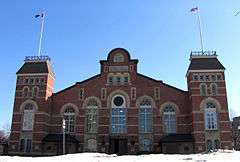 | |
| Major E. J. G. Holland VC Armoury 2100 Walkley Road |
Ottawa |
Houses the 33 Signal Regiment, 33 Combat Engineer Regiment, 28 (Ottawa) Service Battalion, and 33 Military Police Platoon. |
||||
| Morrison Battery Park 307 deNiverville Private |
Ottawa |
Located on CFB Uplands in Ottawa, Morrison Battery Park was created during the rebuild of CFRB Dow's Lake following a collapsed roof in the winter of 2009. It is composed of sprung shelters and a series of joined office trailers. It mainly houses 30th Field Artillery Regiment but is also used as training space for other CAF Reserve units and cadet corp training. |
||||
| Col Welsford MacDonald Armoury 31 Union Street (off Dawson Street) |
Pictou, Nova Scotia |
Housing The Nova Scotia Highlanders, this centrally located building has a flat roof. |
||||
| Lieutenant Colonel William (Billy) Mulherin Madawaska Road |
Grand Falls, New Brunswick |
Housing “C” Company of The Royal New Brunswick Regiment, and 314 Squadron Air Cadets this centrally located, drill hall projects a solid, fortified appearance. |
||||
| Oakville Armoury | Canada's Register of Historic Places | Oakville, Ontario |
Large centrally located building with a low-pitched gable roof; home of A company, The Lorne Scots (Peel, Dufferin and Halton Regiment), 32 Canadian Brigade Group. |
 | ||
| Pembroke Armoury 177 Victoria Street |
1913-14 David Ewart | Recognized - 1992 Register of the Government of Canada Heritage Buildings | Pembroke, Ontario |
Large centrally located Baronial style building with a low-pitched gable roof. |
||
| Petawawa Armoury | Petawawa, Ontario |
Housing 1st and 3rd Battalion The Royal Canadian Regiment, this large centrally located building has a low-pitched gable roof. |
||||
| Peterborough Drill Hall[21] 220 Murray Street, |
1907-8 (completed) David Ewart | 1989 National Historic Sites of Canada; 1990 Classified on the Register of the Government of Canada Heritage Buildings | Peterborough 44°18′31.16″N 78°19′20.26″W / 44.3086556°N 78.3222944°W |
"Riding a wave of national pride and military enthusiasm following the South African War (1899-1902), the Canadian government embarked on a major reform of the nation's defence system. The new programme included an expanded and upgraded militia and the construction of new armouries across the country. Recalling a Baronial style fortress in its turrets, arched troop doors and crenellated roof line, this is one of the largest and best designed examples from this period. It is home to the Hastings and Prince Edward Regiment of the Canadian Armed Forces (Reserve)." Historic Sites and Monuments Board of Canada |
 | |
| Port Arthur Armoury Park Street at Second Street |
1913-14 David Ewart | Port Arthur, Ontario |
A centrally located large brick Baronial style building with a low-pitched gable roof. |
|||
| Prince Albert Armoury 10th Street East at 8th Avenue East |
1914 Edgar L. Horwood | Recognized - 1988 on the Register of the Government of Canada Heritage Buildings | Prince Albert, Saskatchewan |
A large brick Romanesque Revival building with a low-pitched gable roof is centrally located on open terrain adjacent to exhibition grounds. |
||
| Portage la Prairie Armoury 143 Second Street |
1912-13 David Ewart | Canada's Register of Historic Places; Recognized - 1998 on the Register of the Government of Canada Heritage Buildings | Portage la Prairie, Manitoba |
Centrally located in a newer residential area, the two-storey, flat-roofed, red brick Baronial style building has a stone basement and trim. |
||
| Grande Allée Drill Hall Cove Field, 805 Wilfrid-Laurier Ave[22][23][24] |
1887 (completed) Eugène-Étienne Taché; 1888 Henry James;[25] | 1986 National Historic Sites of Canada; Classified - 1987 Register of the Government of Canada Heritage Buildings | Quebec City 46°48′22.68″N 71°12′50.4″W / 46.8063000°N 71.214000°W |
Designed to house Les Voltigeurs de Québec, it was the precursor of the Chateau-style in Canadian architecture; unique among armouries in Canada due to its design, it was heavily damaged by fire in 2008. |
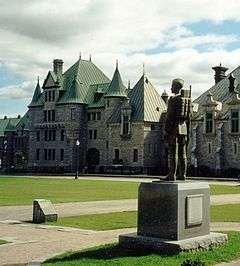 | |
| Quebec Armoury and HMCS Montcalm Training Centre 835 Laurier Avenue East |
1938-9 Charles D. Sutherland | Canada's Register of Historic Places | Quebec City, Quebec |
Overlooking the historic battlefield of Quebec, the rectangular 3-storey stone building is in the picturesque Chateau-style. |
||
| Rossland Armoury | 1904 David Ewart | Rossland, British Columbia |
Centrally located, the Baronial style building has a gable roof. |
|||
| Barrack Green Armoury 60 Broadview Avenue (Carmarthen Street at Broadview Avenue) |
1910-11 David Ewart | Canada's Register of Historic Places; Recognized - 1991 Register of the Government of Canada Heritage Buildings | Saint John, New Brunswick |
Visible from the town centre, the large, solid, two-storey, rectangular Baronial style building with a low-pitched gable roof is on a hillside within the industrial sector. |
||
| Sussex Armoury | 1902 David Ewart | Sussex, New Brunswick |
Centrally located, the Baronial style building has a low-pitched gable roof. |
|||
| Summerside Armoury 33 Summer Street |
1910-1911 David Ewart | Canada's Register of Historic Places | Summerside, Prince Edward Island |
Centrally located stone and brick Baronial style building replaced an earlier military Drill Shed. |
||
| Red Deer Armoury Fire Hall #1 4905 - 49 Street |
1913 Charles Arthur Julian Sharman | Canada's Register of Historic Places | Red Deer, Alberta |
A two and one-half storey rectangular solid brick building in the Edwardian Baroque Free Style. |
||
| Regina Armoury 1600 Elphinstone Avenue |
1928 Thomas W. Fuller | Recognized - 1998 on the Register of the Government of Canada Heritage Buildings | Regina, Saskatchewan |
This centrally located Romanesque Revival fortress like building with a low-pitched gable roof is in a modern residential neighbourhood adjacent to the Regina Exhibition Grounds. Organizations that use the armoury include: Regina units of 38 Canadian Brigade Group: 10th Field Regiment, Royal Canadian Artillery, Royal Regina Rifles, 16th (Saskatchewan) Service Battalion, 16th Medical Company, cadet corps and the Military Museum of Saskatchewan. |
||
| Rimouski Armoury 65 Saint-Jean-Baptiste Street East |
1910-11 David Ewart | Canada's Register of Historic Places; Recognized - 1991 Register of the Government of Canada Heritage Buildings | Rimouski, Quebec | Housing Les Fusiliers du St-Laurent, this centrally located red brick Baronial style structure`s compact, solid volume creates a strong visual presence. |  | |
| Rivière-du-Loup Armoury Joly Street |
1904 David Ewart | Canada's Register of Historic Places | Rivière-du-Loup, Quebec |
Centrally located, symmetrical Baronial style building whose two two-storey wings flank the dominant centre pavilion. |
||
| Rouyn Armoury Perreault Street E |
1935-6 Thomas W. Fuller | Recognized - 1983 Register of the Government of Canada Heritage Buildings | Rouyn, Quebec |
Centrally located, symmetrical Baronial style building with a steeply pitched gable roof. |
||
| William Street Armoury 315 William St Sherbrooke QC J1H 4E8 Tel 819.564.4252 |
Sherbrooke, Quebec |
The front facing portion is the former Sherbrooke Court House, convenient to the adjacent former Winter Street Prison. The layout is a central hallway with two former courtrooms behind the front facade, offices beyond, QM in the basement and a mess on the entire second floor. A large steel gable roof drill hall is nested behind the offices, and is accessible from a large door on Winter Street. |
 | |||
| Belvédère Street Armoury Belvedere Road South |
1907-8 David Ewart | Canada's Register of Historic Places; Recognized - 1991 Register of the Government of Canada Heritage Buildings | Sherbrooke, Quebec |
Housing Les Fusiliers de Sherbrooke, this large centrally located Baronial style building with a low-pitched gable roof, has a large, unobstructed drill hall space. |
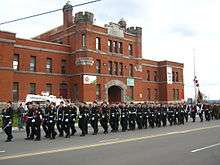 | |
| LCol Daniel J Murray Armoury 72 North Street |
Springhill, Nova Scotia |
Housing The Nova Scotia Highlanders, this centrally located building has a flat roof. |
||||
| St. Catharines Armoury 81 Lake Street at Elizabeth Street |
1905 David Ewart | Recognized 1991 Register of the Government of Canada Heritage Buildings; | St. Catharines, Ontario |
Housing The Lincoln and Welland Regiment, and 10th Battary, 56th Field Regiment RCA[26] this centrally located large, brick Baronial style structure with a low-pitched gable roof, has a sturdy, military appearance. |
 | |
| Laframboise Street Armoury 2155 Laframboise Blvd |
1905-6 David Ewart | Canada's Register of Historic Places;Recognized - 2005 Register of the Government of Canada Heritage Buildings | Saint-Hyacinthe, Quebec |
Housing 6th Battalion of Royal 22e Régiment, this centrally-located brick and stone Baronial style building is composed of a drill hall, a simple rectangular block with a gable roof, and the north block. |
 | |
| St Jean Baptiste Street Armoury St-Jean-Baptiste Street |
Rimouski, Quebec | |||||
| CWO Couture OMM, CD drill hall building 16 | 2012 | Saint-Jean-sur-Richelieu | ||||
| St. Mary's Armouries 26 Water Street South |
1868 | St. Marys, Ontario |
Centrally-located three-storey limestone Tudorbethan building. |
|||
| St. Thomas Armoury Chester and Wilson Streets |
1901-2 David Ewart | Recognized - 1992 Register of the Government of Canada Heritage Buildings | St. Thomas, Ontario |
Housing 7 Engineer Squadron 31 Combat Engineer Regiment (The Elgins), this centrally located rectangular, gable-roofed Baronial style building is of solid, compact appearance. |
||
| Stratford Armoury Waterloo Street at Albert Street |
1904-05 Hubert Carroll McBride | Recognized - 1992 Register of the Government of Canada Heritage Buildings | Stratford, Ontario |
Housing 4th Battalion, The Royal Canadian Regiment, this centrally located fortress-like Romanesque Revival brick building with a low-pitched gable roof features prominent corner towers. |
||
| Strathcona Armoury | 1911-12 David Ewart | Strathcona, Alberta |
Centrally located rectangular, gable-roofed Baronial style building of solid, compact appearance. |
|||
| Strathroy Armoury Frank Street at James Street |
1907 David Ewart | Strathroy, Ontario |
Centrally located rectangular, gable-roofed Baronial style building of solid, compact appearance. |
|||
| Thunder Bay Armoury 317 Park Avenue |
1913 David Ewart | Canada's Register of Historic Places | Thunder Bay, Ontario |
Housing The Lake Superior Scottish Regiment, this two-storey, gable-roofed Baronial style drill hall is centrally located. |
||
| Toronto Drill Hall University Avenue at Armoury Street |
1891-93 Thomas Fuller (architect) and Henry Langley | Toronto, Ontario |
Neo-Gothic style Dominion style building which formerly held 25 Field Ambulance; 48th Highlanders of Canada; 7th Toronto Regiment Royal Canadian Artillery; and The Queen's Own Rifles of Canada was demolished 1963. |
| ||
| Moss Park Armoury 130 Queen Street East |
Canada's Register of Historic Places | Toronto, Ontario |
Housing 25 Field Ambulance, 48th Highlanders of Canada, 7th Toronto Regiment Royal Canadian Artillery, The Queen's Own Rifles of Canada and 32 Canadian Brigade Group Headquarters. This large centrally located building has a low-pitched gable roof. |
| ||
| Fort York Armoury 660-700 Fleet Street |
1933-35 Ferdinand Herbert Marani of Marani, Lawson and Morris | 1991 Federal Heritage building; on the Register of the Government of Canada Heritage Buildings | Toronto, Ontario |
Designed in an industrial area of Toronto; this large, two-storey, drill hall with a concrete, vaulted roof is home to The Royal Regiment of Canada, Queen's York Rangers (1st American Regiment), The Toronto Scottish Regiment (Queen Elizabeth The Queen Mother's Own), 32 Canadian Brigade Group. |
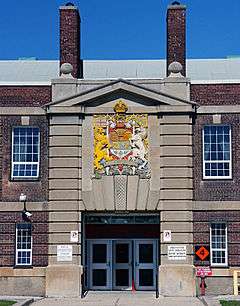 | |
| Denison Armoury 1 Yukon Lane |
Canada's Register of Historic Places | Toronto, Ontario |
Large centrally located building with a low-pitched gable roof houses 32 Canadian Brigade Group Headquarters; The Governor General's Horse Guards; 2 Intelligence Company; 32 Combat Engineer Regiment; 32 Service Battalion; 32 Military Police Platoon; 2 Area Support Group Signal Squadron Charlie Troop; ASU Toronto. |
|||
| Général Jean-Victor Allard Armoury 574 St. Francois-Xavier Street, corner of Sainte Geneviève |
1905-6 David Ewart | Canada's Register of Historic Places; Recognized - 1991 Register of the Government of Canada Heritage Buildings | Trois-Rivières, Quebec |
Housing 12e Régiment blindé du Canada, and their regimental museum, this two-storey, functional red brick Baronial style building with a low-pitched gable roof is located in a residential neighbourhood. |
 | |
| Truro Armoury 126 Willow Street |
1874 Thomas Seaton Scott | Canada's Register of Historic Places; Recognized - 1991 Register of the Government of Canada Heritage Buildings | Truro, Nova Scotia |
Housing 1st Battalion, The Nova Scotia Highlanders, this centrally located box-like Dominion style Neo-Gothic style building with a flat roof was designed with classical inspiration. |
||
| Seaforth Armoury 1650 Burrard Street |
1936 (completed) Thomas W. Fuller | Canada's Register of Historic Places;Classified - 1997 Register of the Government of Canada Heritage Buildings | Vancouver |
Designed by architects McCarter and Nairne, the massive, low-massed, asymmetrical, concrete Romanesque Revival structure with a fortified appearance is as a Class A Heritage Building in downtown Vancouver housing The Seaforth Highlanders of Canada. |
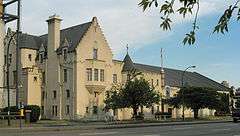 | |
| Tommy Holmes VC Memorial Armoury 858-10th Street East | Owen Sound, Ontario |
Houses "A" Company of The Grey and Simcoe Foresters. Tommy Holmes was Canada's youngest Victoria Cross winner |
||||
| Lt. Col. James Pemberton Fell (J.P. Fell) Armoury | 1914 David Ewart | Recognized - 1988 on the Register of the Government of Canada Heritage Buildings | North Vancouver |
Large centrally located Baronial style building with a low-pitched gable roof adjacent to a residential area and Mahon Park. The Armoury, which houses the 6 Field Engineer Museum, was named for the first Commanding Officer of 6th Field Company. [27] |
||
| Beatty Street Drill Hall 620 Beatty Street at Dunsmuir Street |
1899-1900 David Ewart | Canada's Register of Historic Places; Vancouver landmark and class-A heritage building | Vancouver |
Built to house The British Columbia Regiment (Duke of Connaught's Own), this massive, low-massed symmetrically composed Baronial style structure with two large castle-like turrets complete with battlements, whose main entrance is a central troop door. |
 | |
| Bessborough Armoury 2025 West 11th Avenue |
1932-3 Thomas W. Fuller | Canada's Register of Historic Places; Vancouver Inventory of heritage buildings "B" Category; Recognized - 1997 - Register of the Government of Canada Heritage Buildings; | Vancouver |
Large Romanesque Revival structure with a low-pitched gable roof on a flat site faced by mature trees within an area of containing light industry, and adjacent to a residential area. |
||
| Seaforth Armoury 1650 Burrard Street |
1936 McCarter and Nairne | Vancouver |
Centrally located box-like Baronial style building with a peaked roof with castle like inspiration. |
|||
| Brigadier Murphy Armoury 29th & 21st Avenue ASU Chilliwack (Vernon) |
1913 David Ewart | Canada's Register of Historic Places; Recognized - 1997 Register of the Government of Canada Heritage Buildings | Vernon, British Columbia |
Designed from a standard plan, this two-storey Baronial style drill hall has simple horizontal massing and modest but strong detailing. |
||
| Lt. General E. C. Ashton Armoury 724 Vanalman Avenue |
1994 | Victoria, British Columbia | Houses 11 Services Company 39 Service Battalion, 11 (Victoria) Field Ambulance, 11 Military Police Platoon, the Lieutenant-General E. C. Ashton Armoury Museum[28] and No. 3005, Royal Canadian Army Cadet Corps | |||
| Bay Street Drill Hall[29] at McBride Street | 1913-14 William Ridgway Wilson | 1989 National Historic Sites of Canada;Recognized - 1991 Register of the Government of Canada Heritage Buildings | Victoria 48°26′6.75″N 123°21′50.16″W / 48.4352083°N 123.3639333°W |
Built to house the Fifth Regiment; Housing The Canadian Scottish Regiment (Princess Mary's), this large fortress-like Baronial style structure of brick, steel and concrete features towers, crenellated turrets, and detailing with Tudorbethan elements. Built during the 1896 to 1918 period when over 100 drill halls and armouries were erected across Canada; its scale reflects the dramatic increase in military participation following Canada’s performance during the Second Boer War. | ||
| Menzies Street Drill Hall | 1889 Henry James | Victoria, British Columbia |
In addition to the Drill Hall, this complex consisted of Guard House, officers residences, and quartermaster's stores for the Militia Dept.[30] |
|||
| Virden Armoury Bay Street at McBride Street | 1913 David Ewart | Virden, Manitoba |
This gable-roofed Baronial style drill hall is centrally located. |
|||
| Tommy Prince Drill Hall CFB Wainwright |
Wainwright, Alberta | Named in honour of Sergeant Tommy Prince | ||||
| Walkerton Armoury | 1907 David Ewart | Walkerton, Ontario |
This gable-roofed Baronial style drill hall is centrally located. |
|||
| Wellington Armoury 23 High Street |
Canada's Register of Historic Places | Wellington, Ontario |
Located at the northeast corner of High and Clyde Streets, abutting the Grand River, in the former Village of Elora. |
|||
| Maj FA Tilson VC Armoury 353 Freedom Way |
1899-02 David Ewart | Canada's Register of Historic Places | Windsor, Ontario |
Housing The Essex and Kent Scottish, this two-storey, red brick Baronial style structure with a three-storey tower is centrally-located. |
||
| Winnipeg Drill Hall & B8-Drill Hall (Korea Hall) 1984 Grant Avenue Canadian Forces Base Winnipeg |
1941 Charles D. Sutherland | Drill Hall Building 21 Recognized - 1997; Drill Hall Korea Hall B8 Recognized - 2004 Register of the Government of Canada Heritage Buildings | Winnipeg, Manitoba |
Large centrally located wood, metal and brick building with a low-pitched gable roof with a large interior space for the drill hall, and low, shed-roofed ‘lean-tos’ running along its north and south elevations. |
B21, B8 | |
| Minto Armoury St. Matthew's Avenue at Minto Street |
1914-15 David Ewart | Canada's Register of Historic Places; Recognized - 1991 Register of the Government of Canada Heritage Buildings | Winnipeg, Manitoba |
Centrally located large, red brick Baronial style structure, exemplified by sturdy, crenellated corner towers and low arched roof. |
||
| McGregor Armoury 515 Machray Avenue |
1914-5 David Ewart | Canada's Register of Historic Places; Recognized - 1994 Register of the Government of Canada Heritage Buildings; | Winnipeg, Manitoba |
Housing The Fort Garry Horse, 31 Engineer Squadron,[31] and The Fort Garry Horse Museum and Archives,[32] as well as 3 cadet squadrons this centrally located drill hall has Baronial style façades; stepped parapet profiles, low arched troop door and corner towers. |
||
| Woodstock Armoury Chapel Street |
1904-5 David Ewart | Canada's Register of Historic Places; Recognized - 1991 Register of the Government of Canada Heritage Buildings | Woodstock, New Brunswick |
Centrally located, symmetrical Baronial style building with two two-storey wings flanking a central pavilion. |
||
| Yorkton Armoury 56 1st Avenue (Smith Street at Betts Avenue) |
1939 Charles D. Sutherland | Recognized - 1998 Register of the Government of Canada Heritage Buildings | Yorkton, Saskatchewan |
Centrally located two-storey T-shaped building with a low-pitched gable roof. |
||
References
- ↑ http://dictionaryofarchitectsincanada.org/appendix_a List of Dominion Architects of Canada
- ↑ http://dictionaryofarchitectsincanada.org Chief Dominion Architect
- ↑ "Henry James inf. from M. Archibald, By Federal Design: The Chief Architects Branch of the Department of Public Works 1881-1914". Dictionary of architects in Canada. Retrieved 15 Aug 2014.
- ↑ "Paul Weatherbe inf. from M. Archibald, By Federal Design: The Chief Architects Branch of the Department of Public Works 1881-1914". Dictionary of architects in Canada. Retrieved 15 Aug 2014.
- ↑ Directory of Federal Real Property Treasury Board of Canada Secretariat
- ↑ Henry James
- ↑ Mewata Drill Hall / Calgary Drill Hall. Canadian Register of Historic Places.
- ↑ Metawa Drill Hall, Directory of Designations of National Historic Significance of Canada
- ↑ Stormont, Dundas and Glengarry Highlanders Regimental Museum
- ↑ Arm Lads Brigade Armoury
- ↑ Durrell Museum
- ↑ Loyal Edmonton Regiment Military Museum
- ↑ City of Edmonton Archives
- ↑ Telephone Historical Centre
- ↑ Former Elora Drill Shed. Canadian Register of Historic Places.
- ↑ Enderby Drill Hall
- ↑ Henry James
- ↑ Princess of Wales' Own Regiment Military Museum
- ↑ "Black Watch (Royal Highland Regiment) of Canada Armoury National Historic Site". Designations of National Historic Significance. Parks Canada. Retrieved 13 August 2012.
- ↑ "Karl Branwhite Spurgin". Dictionary of architects in Canada. Retrieved 14 Aug 2014.
- ↑ Peterborough Drill Hall / Armoury. Canadian Register of Historic Places.
- ↑ "Grande Allée Drill Hall". Directory of Designations of National Historic Significance of Canada. Parks Canada. Retrieved 2011-08-27.
- ↑ Grande Allée Drill Hall. Canadian Register of Historic Places. Retrieved 2011-08-27.
- ↑ "Final Report - Public Consultations on the Future of Quebec City's Grande-Allée Armoury". 29 September 2009. Public Works and Government Services Canada. Retrieved 4 September 2011.
- ↑ Henry James
- ↑ http://www.army-armee.forces.gc.ca/en/56-field-artillery-regiment/index.page
- ↑ http://www.cmp-cpm.forces.gc.ca/dhh-dhp/nic-inm/sm-rm/mdsr-rdr-eng.asp?PID=6875 Lt. Col. James Pemberton Fell Armoury
- ↑ Lt. General E. C. Ashton Armoury Museum
- ↑ Bay Street Drill Hall. Canadian Register of Historic Places. Retrieved 23 October 2011.
- ↑ "Henry James". Dictionary of architects in Canada. Retrieved 14 Aug 2014.
- ↑ Canadian Military Engineers#Reserve Force units
- ↑ The Fort Garry Horse Museum and Archives
| Wikimedia Commons has media related to Armouries in Canada. |
}
External links
- Federal Heritage Buildings
- Canada's Register of Historic Places
- Thomas Seaton Scott, Chief Dominion Architect 1872-1881
- Thomas Fuller (architect), Chief Dominion Architect 1881-1896
- David Ewart, Chief Dominion Architect 1896-1914
- Richard Cotsman Wright, Chief Dominion Architect 1918-1927]
- Thomas W. Fuller, Chief Dominion Architect 1927-1936
- Hubert Carroll McBride
- Charles Arthur Julian Sharman
- Donald Norman MacVicar
- Ferdinand Herbert Marani